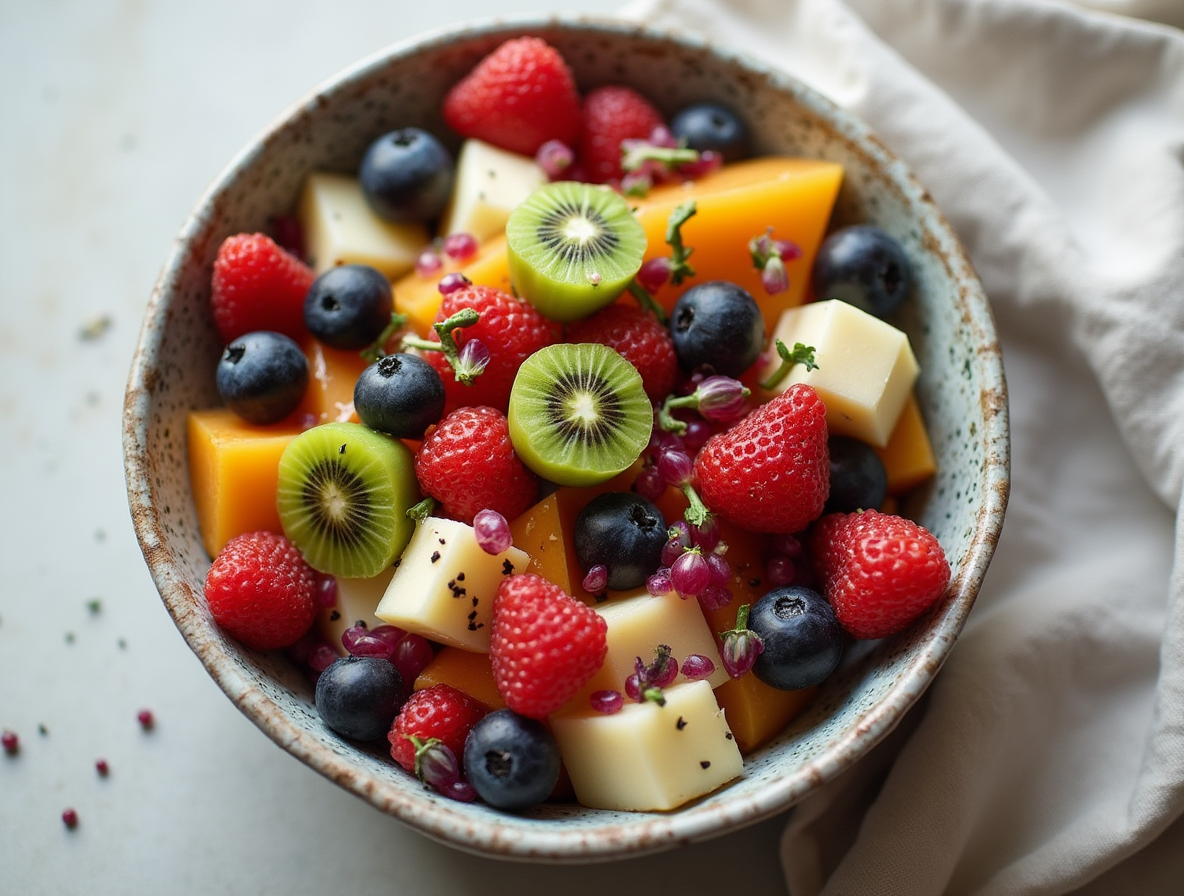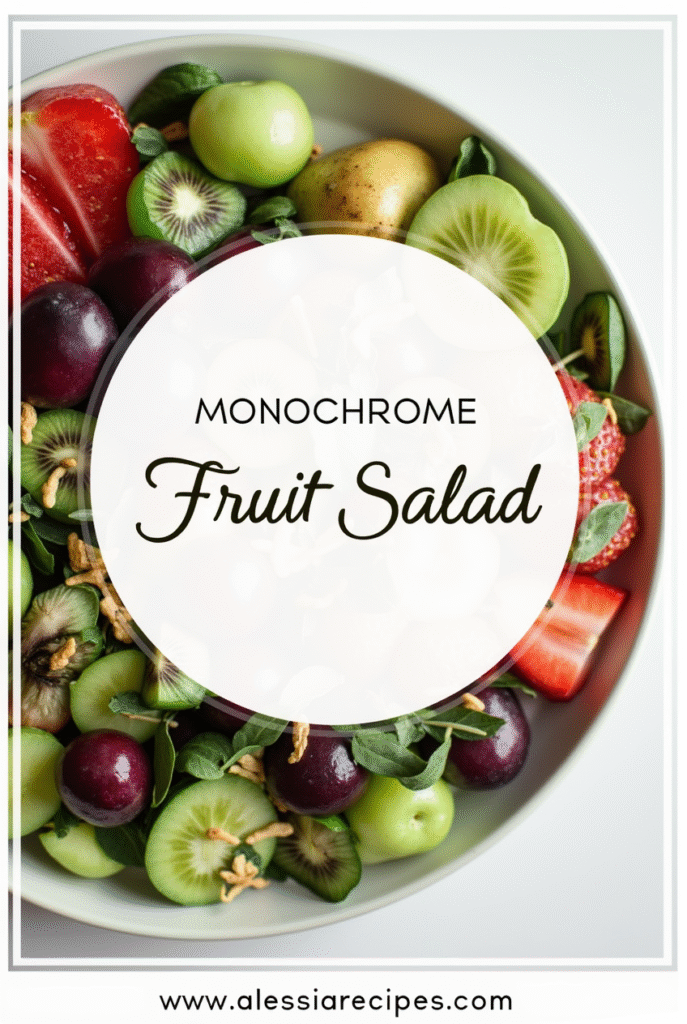How to Make an Elevated Fruit Salad: A Chef’s Monochrome Method
An elevated fruit salad doesn’t require complex techniques or exotic ingredients—just a dash of creativity and a keen eye for color. I’ve discovered that creating a monochromatic fruit display transforms ordinary ingredients into a visually stunning dish that impresses guests while taking only 20 minutes to prepare.
The beauty of this approach lies in its versatility. For instance, a purple-black palette might feature black plums, blackberries, and black cherries, while a red theme could showcase strawberries, raspberries, and pomegranate seeds. This gourmet fruit salad concept works with any color scheme—green, yellow, blue—allowing you to craft a fancy fruit salad that’s both classic and innovative. Additionally, a simple dressing of lime juice, zest, and honey not only prevents browning but enhances the natural flavors of your carefully selected fruits. In fact, preparing your fruit salad in advance allows the flavors to meld together, creating an even more remarkable taste experience.
Choosing Fruits for a Monochrome Palette
The magic of a monochromatic fruit salad begins with thoughtful selection. When crafting an elevated fruit salad with a single-color theme, I carefully consider not just the hue, but also the texture, ripeness, and flavor profiles of each component.
Selecting a specific color palette creates a stunning visual impact. Green palettes flourish with honeydew melon, green grapes, kiwi, and Granny Smith apples. These green fruits aren’t just esthetically pleasing—they’re packed with essential nutrients like Vitamin A, Vitamin C, potassium, and folate. Honeydew, furthermore, consists of about 90% water, making it wonderfully hydrating.
For a red theme, I combine strawberries, watermelon, raspberries, and pomegranate seeds. The pomegranate seeds add a sparkling jewel-like quality. Alternatively, a purple-black palette might include black plums, blackberries, black grapes, and cherries for a sophisticated appearance.
Yellow collections shine with pineapple, mango, yellow kiwis, and golden varieties of raspberries. Meanwhile, a blue-green approach creates a unique oceanic feel with blueberries, blackberries, dragon fruit, and honeydew.
Beyond color, I prioritize one or two “superstar” fruits as the foundation. As a chef, I pay particular attention to:
- Texture contrasts: Mix crisp apples with softer berries
- Ripeness levels: Slightly firm bananas hold their shape better than overly ripe ones
- Visual variety: Incorporate different shapes and sizes within your chosen color scheme
Certain fruits should be avoided in gourmet fruit salads—notably overripe bananas that turn mushy and watery melons that can dilute the entire salad. Instead, select fruits that maintain their integrity when cut and mixed.
To preserve the visual appeal, I apply a squeeze of lemon juice to prevent browning. This simple technique keeps the monochrome palette vibrant and fresh-looking. Alternatively, cinnamon can mask any browning while adding complementary flavor notes.
Through this monochromatic approach, a classic fruit salad transforms into a fancy fruit display worthy of any upscale gathering—proving that sometimes, limitation breeds creativity.
Chef Techniques to Elevate Your Fruit Salad
Professional chefs possess a repertoire of techniques that transform basic fruit salads into extraordinary culinary experiences. Beyond selecting the perfect color palette, it’s the subtle chef methods that create those memorable Michelin-star quality dishes.
One chef secret for an elevated fruit salad is the surprising addition of extra virgin olive oil. The technique involves whisking olive oil into citrus juice a few drops at a time until creating a creamy, emulsified dressing that adds depth while enhancing natural fruit flavors. This approach adds richness without overpowering the delicate fruit notes.
Another professional method involves creating concentrated fruit syrups. Chefs bring orange juice, lemon juice, brown sugar, and citrus zest to a boil, then reduce to simmer until slightly thickened. This reduction intensifies flavors dramatically. Similarly, maceration—the process of softening fruit with sugar—draws out natural juices to create a complex, flavorful sauce.
Perhaps the most surprising chef technique is adding a pinch of salt. While counterintuitive, salt actually intensifies sweetness, brightens flavors, and can even counteract bitterness in citrus or other somewhat bitter fruits. This simple addition makes flavors more vibrant without tasting salty.
Strategic layering represents another gourmet approach. Professional chefs arrange fruits beginning with juice-resistant varieties at the bottom, progressing to softer types at the top. This preserves textures and creates visual appeal in your fancy fruit salad.
For cutting techniques, professionals recommend:
- Slicing with a sharp knife using a gentle pulling motion to maximize horizontal movement
- Cutting supremes (pith-free segments) for citrus to eliminate bitterness
- Removing stone fruit pits by cutting around the indentation and twisting halves apart
Consequently, a classic fruit salad becomes a gourmet fruit salad through these subtle yet powerful chef techniques. Prior to serving, refrigerate briefly to allow flavors to meld—though most elevated fruit salad recipes are best enjoyed within hours of preparation.
Presentation and Pairing Ideas
Serving your carefully crafted monochrome creation is where artistry truly meets gastronomy. A clear glass bowl remains the quintessential vessel for an elevated fruit salad, allowing the vibrant colors of your monochromatic palette to shine through. Transparent containers showcase the artistic arrangement, turning your gourmet fruit salad into a centerpiece worthy of attention.
For special occasions, consider a trifle bowl to display your creation—especially beautiful for Christmas morning or Easter celebrations. This presentation style is particularly striking with monochromatic layers visible through the glass. Moreover, fruit salads served in individual glass parfaits create an upscale dining experience, perfect for more formal gatherings.
Beyond the vessel, consider these pairing options to complement your elevated fruit salad:
- Cheese companions: Creamy burrata or salty feta provide delightful contrast with sweet fruits. For a more substantial offering, pair with a firm, salty cheese like ricotta salata to create a balanced flavor profile. Alternatively, experiment with fried goat cheese balls placed directly in the salad for an unexpected textural element.
- Sweet accompaniments: Simple cookies make perfect companions to fruit. Almond macaroons or classic snickerdoodles offer complementary flavors without overwhelming the fruit. For chocolate lovers, remember that each chocolate type pairs differently—dark chocolate with extra-sweet fruits, milk chocolate with most varieties, and white chocolate with tart berries.
The timing of your presentation matters remarkably. For brunch gatherings, prepare as much as possible ahead of time, yet add any edible flowers or delicate garnishes immediately before serving to maintain their freshness. Edible blossoms like lilacs, nasturtiums, or marigolds transform a classic fruit salad into a breathtaking display.
Finally, consider temperature—refrigerate briefly before serving to allow flavors to meld, yet still preserve the fruits’ integrity. For dessert applications, your monochrome creation pairs exceptionally well with vanilla ice cream, whipped cream, or even atop olive oil cake.
Conclusion
Throughout this culinary journey, we’ve explored how a simple shift in perspective transforms ordinary fruit into an extraordinary display. The monochrome method certainly proves that limitation often sparks the greatest creativity. Rather than combining every colorful fruit available, selecting a single color palette creates visual impact that guests remember long after the last bite.
After all, elevated fruit salads don’t require exotic ingredients or complex techniques. The magic happens when thoughtful selection meets proper preparation. A red palette of strawberries and pomegranate seeds dazzles the eye, while a carefully crafted green arrangement offers refreshing elegance. Consequently, your fruit selection becomes both art and nourishment.
Chef techniques take these creations even further. The surprising addition of olive oil emulsion, a strategic pinch of salt, or the patient process of maceration elevates flavor profiles significantly. These subtle touches make the difference between a basic fruit bowl and a memorable culinary experience worthy of any upscale gathering.
Presentation matters tremendously. Clear glass vessels showcase your artistic arrangement, while thoughtful pairings with complementary cheeses or sweet treats create a complete sensory experience. This approach works beautifully for casual brunches and formal dinner parties alike.
The beauty of monochrome fruit salads lies in their adaptability. You can craft these colorful displays year-round using seasonal offerings, making each creation unique to the moment. Undoubtedly, this approach will impress guests while allowing you to express your creativity through food.
Next time you face a bowl of mixed fruit, remember that sometimes less variety creates more impact. Your monochrome masterpiece awaits – a symphony of similar shades that proves simplicity often yields the most sophisticated results.
FAQs
Q1. What is the monochrome method for making an elevated fruit salad? The monochrome method involves selecting fruits of a single color palette to create a visually stunning and gourmet fruit salad. This approach focuses on choosing fruits with similar hues but varying textures and flavors to create an impressive dish.
Q2. How can I prevent my fruit salad from browning? To prevent browning, you can apply a squeeze of lemon juice to cut fruits. Alternatively, you can create a dressing using lime juice, zest, and honey, which not only prevents browning but also enhances the natural flavors of the fruits.
Q3. What are some chef techniques to elevate a fruit salad? Some chef techniques include adding a touch of extra virgin olive oil to create a creamy dressing, using a pinch of salt to intensify sweetness, creating concentrated fruit syrups, and strategically layering fruits based on their texture and juiciness.
Q4. How should I present my monochrome fruit salad? Present your monochrome fruit salad in a clear glass bowl or individual parfait glasses to showcase the vibrant colors. For special occasions, consider using a trifle bowl. You can also garnish with edible flowers or herbs for added visual appeal.
Q5. What are some good pairings for an elevated fruit salad? An elevated fruit salad pairs well with various cheeses like burrata, feta, or fried goat cheese balls. For sweet accompaniments, consider serving it with simple cookies, chocolate, or even vanilla ice cream. It can also be served alongside olive oil cake for a unique dessert option.


